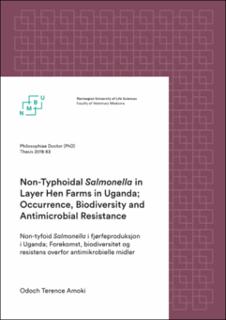| dc.description.abstract | Non-typhoidal Salmonella (NTS) is an important global foodborne pathogen mainly acquired in humans from animal sources through consumption of contaminated animal products, contacts with animals or their environment, contaminated water and vegetables. One of the main sources of NTS is poultry and poultry products. In addition to causing illnesses in humans and animals, NTS is increasingly implicated in the spread of antimicrobial resistance (AMR) between humans and animals. Occurrence of AMR in NTS to commonly used antimicrobials complicates management of infections and limits the choice of drugs. In Uganda, the occurrence of AMR in NTS from livestock (poultry inclusive) is poorly known and yet animal agriculture, which is an important economic activity in many households, could be contributing to the spread of drug resistant NTS. The aim of this study was to determine occurrence, diversity and antimicrobial resistance of non-typhoidal Salmonella in layer hen farms from selected districts of Uganda.
In this thesis, a cross sectional study was designed to collect data from the districts of Wakiso, Masaka and Lira in Uganda. Data was collected in 2015 and 2016 from randomly selected poultry farms after determination of the sample size. Questionnaires were directly administered to collect data on farm management practices, disease prevention and control as well as demographic data of farmers and farm managers. In addition, faecal samples were collected from poultry houses for isolation and identification of NTS isolates. All the isolates were then later tested for antimicrobial susceptibility testing using Kirby disk diffusion methods and minimum inhibitory concentrations (MIC) by micro brsoth dilutions. Molecular subtyping of the isolates was performed by pulsed-field gel electrophoresis (PFGE) and screening for resistance genes and integron genes was done by polymerase chain reaction amplifications. Sequencing was done to detect specific mutations involved in quinolone resistance.
A total of 237 farms were involved in this study. Farm prevalence of NTS was estimated at 20.7 % of the study farms (95 % confidence interval (CI): 15.6 – 25.6 %). Altogether, 11 NTS serovars were identified (Newport, Hadar, Aberdeen, Heidelberg, Bolton, Mbandaka, Uganda, Typhimurium, Enteritidis, Kampala, Zanzibar), these were further typed by PFGE into 15 pulsotypes and 10 nontypable isolates. Large farms and the presence of other animal species on the farm were associated with NTS prevalence on farms. However, having a separate house for birds newly brought to the farms was found to be protective (OR = 0,4; 95 % CI: 0.2–0.8).
A high level of phenotypic AMR in NTS was estimated (57.7 % of the isolates), the highest level observed was resistance to ciprofloxacin (50.0 %) followed by resistance to sulfonamides (26.9 %) and resistance to sulfamethoxazole/trimethoprim (7.7 %). Resistance was significantly associated with sampled districts (p = 0.034). Multidrug-resistance (MDR) was detected in 15.4 % of the isolates. Resistance to ampicillin was linked to farm size with large farms being more likely to display ampicillin resistance. Resistance towards trimethoprim was linked positively to resistance towards sulfonamides, sulfamethoxazole/trimethoprim and ciprofloxacin. Resistance towards sulfonamides was also linked positively to resistance to ciprofloxacin. There was also a positive association between resistance to chloramphenicol and ampicillin, with all isolates being either both susceptible or resistant. Seven AMR genes (blaTEM-1, cmlA, tetA, qnrS, sul1, dhfrI/dhfrVII) conferring resistance to major classes of antimicrobials (beta lactams, chloramphenicol, tetracyclines, quinolones, sulfonamides, trimethoprim, respectively) commonly used in human and veterinary medicine were identified. Six (11 %) of the phenotypically resistant isolates carried genes that encode for class 1 integrons.
In this study high levels of reduced susceptibility (37.7 % of the 85 samples tested) to ciprofloxacin in NTS was detected and this was significantly associated with the districts where they were isolated (p= 0.014) and presence of qnrS genes (p<0.01). However, none of the isolates had the classical mutations at gyrA (S83F and D87N)/gyrA (S83F and D87G) and parC (T57S and S80R) normally associated with quinolone resistance in Salmonella.
The high prevalence of NTS estimated in this study and determination of some factors associated with NTS in layer hen farms in Uganda is important information that should inform local, national and international efforts to control NTS. In addition, the determination of AMR patterns, linkages, and genes to important antimicrobials used in human and veterinary medicine calls for immediate and concerted efforts to strengthen strategies to combat AMR. It is recommended that more longitudinal studies involving wider geographic coverage to further understanding of occurrence of AMR and underlying mechanisms in NTS isolates from livestock is performed. This is particularly urgent in Uganda and other developing countries where data is still very limited. | en_US |
| dc.description.abstract | Non-tyfoid Salmonella (NTS) er på globalt nivå viktige matbårne patogener. Mennesker smittes ofte gjennom konsum av forurensede animale produkter, vann og frukt/grønt, eller ved direkte kontakt med dyr og dyrenes miljø. En av de viktigste kildene for smitte med NTS er fjørfe og fjørfeprodukter. I tillegg til at disse bakteriene forårsaker sykdom hos mennesker og dyr, settes NTS også i økende grad i forbindelse med spredning av antimikrobiell resistens (AMR) mellom dyr og mennesker. Opptreden av resistens overfor vanlig brukte antimikrobielle midler i NTS kompliserer håndtering av sykdom og begrenser valg av medikamenter. Det er lite kunnskap om forekomsten av AMR i NTS isolert fra husdyr (inkludert fjørfe) i Uganda. Det er imidlertid mulighet for at husdyrproduksjon, som er en viktig inntektskilde for mange familier og husholdninger, kan bidra til spredning av resistente NTS. Formålet med denne studien var å kartlegge forekomst, biodiversitet og resistens overfor antimikrobielle midler i NTS i fjørfebesetninger i utvalgte distrikter i Uganda. | en_US |

